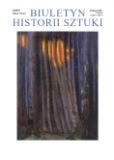Inspiracje sztuką japońską we wczesnych grafikach Jana Rubczaka
Inspirations Derived from Japanese Art in Jan Rubczak's Early Prints
Author(s): Katarzyna KeslingSubject(s): Visual Arts, Recent History (1900 till today), History of Art
Published by: Instytut Sztuki Polskiej Akademii Nauk
Keywords: Jan Rubczak; graphics at the turn of the 19th and 20th centuries; inspiration with Japanese art; Józef Pankiewicz;
Summary/Abstract: Early artistic activity of Jan Rubczak coincides with his studies at the Academy of Fine Arts in Cracow. Developing his skills at that time, the young artist focused particularly on prints. The etchings and aquatints he executed over the period display high quality of craftsmanship. Similarly as many European artists at the turn of the 20th century, Rubczak was also influenced by Japanese art. Fascination with the art of the Far East that encompassed, among others, painting, drawing, prints, but also literature, theatre, and fashion, was observed already from the second half of the 19th century. Beginning with the moment of Japan opening up to the world after the empire’s isolation, a number of publications dedicated to its history and culture were published, this greatly contributing to promoting the knowledge of the country. Japanese art pieces reached the European market, and were promptly used to adorn interiors, but also as props by artists, e.g., painters. By the end of the 19th century, Japanese art had become known to a wider circle of the public, not just art connoisseurs and collectors, but also to the public of Paris, Vienna, or Munich. Information on Japanese art reached Poland first of all via France where many Polish artists flocked (among them Józef Pankiewicz who was Jan Rubczak’s teacher). An important role in promoting knowledge of Japan was also played by Pankiewicz’s friend Feliks Manghha Jasieński. His extraordinary collection including, among other things, Japanese woodlock prints, drawings, and everyday objects from the Far East, could be admired by those who showed interest. Jan Rubczak must have been among them. The new mode of structuring the composition, fragmentary framing, emphasis on the foreground, and asymmetry are just a few of the solutions which inspired the artist to create interesting works imbued with the atmosphere of Young Poland.
Journal: Biuletyn Historii Sztuki
- Issue Year: 81/2019
- Issue No: 4
- Page Range: 627-646
- Page Count: 20
- Language: Polish

